James Robert "Bob" Stanfield Natural Resources Center
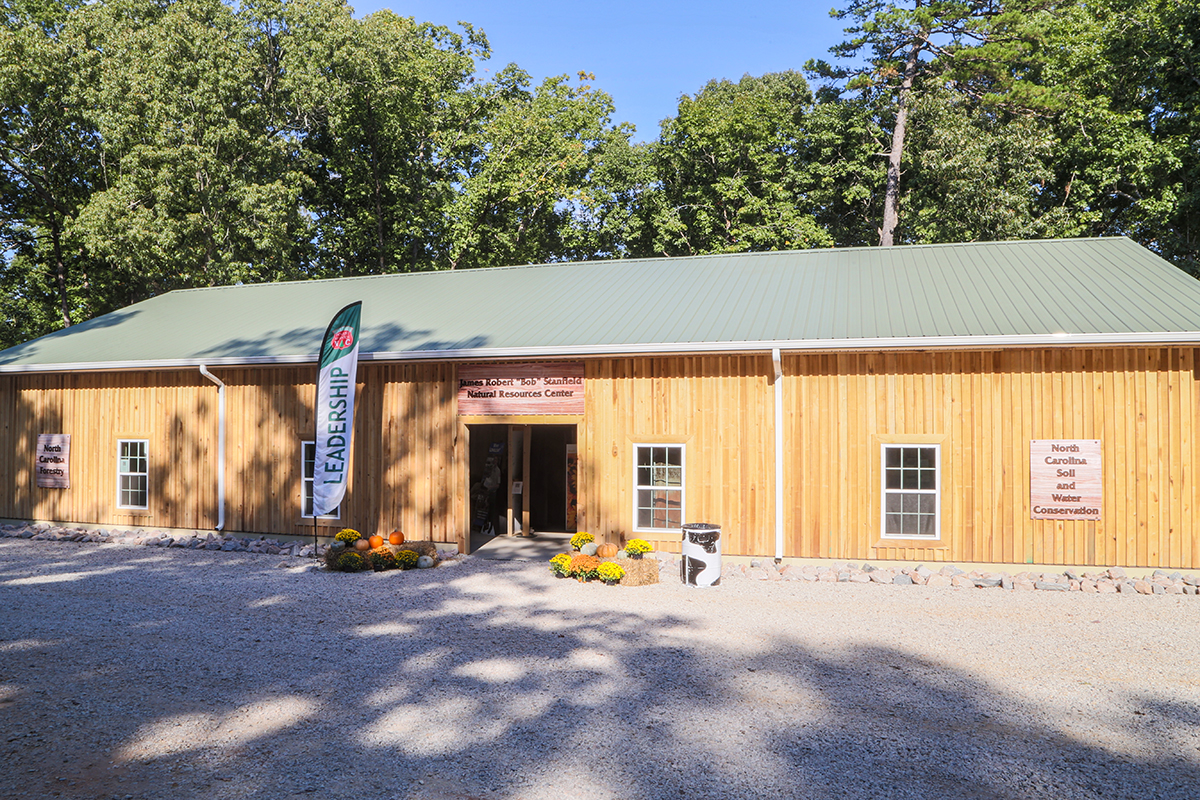
The James Robert "Bob" Stanfield Natural Resources Center is a new addition to the N.C. Forest Service and N.C. Soil and Water Conservation exhibit area located just inside Gate 6 at the N.C. State Fairgrounds in Raleigh.
This building recognizes North Carolina’s strong forest sector, showcasing native tree species from the mountains to the coast and the powerhouse forest products industry that contributed $34.9 billion to North Carolina’s economy in 2019. The building’s exterior is clad with yellow-poplar while the interior walls are paneled with 29 different major tree species native to North Carolina.
► Examples of North Carolina’s Major Native Tree Species
American Basswood (Tilia americana)
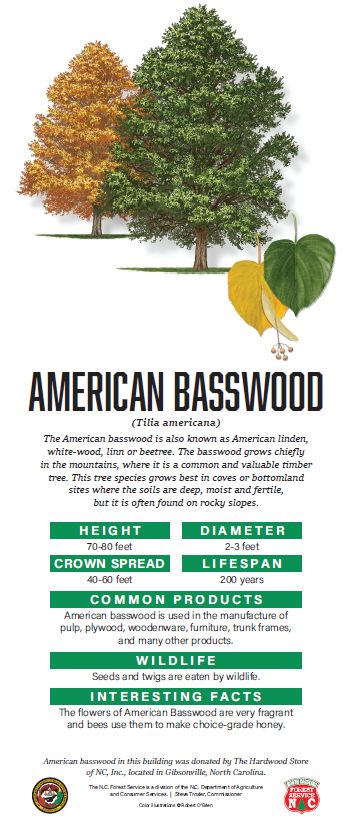 The American basswood is also known as American linden, white-wood, linn or beetree. The basswood grows chiefly in the mountains, where it is a common and valuable timber tree. This tree species grows best in coves or bottomland sites where the soils are deep, moist and fertile, but it is often found on rocky slopes.
The American basswood is also known as American linden, white-wood, linn or beetree. The basswood grows chiefly in the mountains, where it is a common and valuable timber tree. This tree species grows best in coves or bottomland sites where the soils are deep, moist and fertile, but it is often found on rocky slopes.
| Height: 70-80 feet | Diameter: 2-3 feet | |
| Crown Spread: 40-60 feet | Lifespan: 200 years |
Wildlife: Seeds and twigs are eaten by wildlife.
Interesting Facts: The flowers of American Basswood are very fragrant and bees use them to make choice-grade honey.
American basswood in the N.C. State Fair Forest Conservation Center was donated by The Hardwood Store of NC, Inc., located in Gibsonville, North Carolina.
American Beech (Fagus grandifolia)
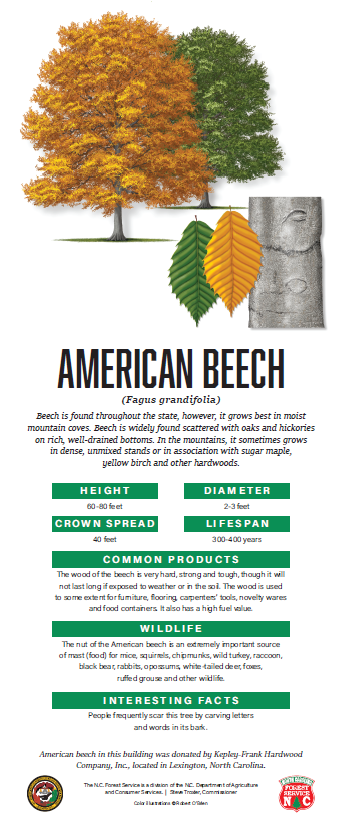 Beech is found throughout the state, however, it grows best in moist mountain coves. Beech is widely found scattered with oaks and hickories on rich, well-drained bottoms. In the mountains, it sometimes grows in dense, unmixed stands or in association with sugar maple, yellow birch and other hardwoods.
Beech is found throughout the state, however, it grows best in moist mountain coves. Beech is widely found scattered with oaks and hickories on rich, well-drained bottoms. In the mountains, it sometimes grows in dense, unmixed stands or in association with sugar maple, yellow birch and other hardwoods.
| Height: 60-80 feet | Diameter: 2-3 feet | |
| Crown Spread: 40 feet | Lifespan: 300-400 years |
Wildlife: Nuts are an important source of food for mice, squirrels, chipmunks, wild turkey, raccoon, black bear, and other wildlife.
Interesting Facts: People frequently scar this tree by carving letters and words in its bark.
American beech in this building was donated by Kepley-Frank Hardwood Company, Inc., located in Lexington, North Carolina.
American Sycamore (Platanus occidentalis)
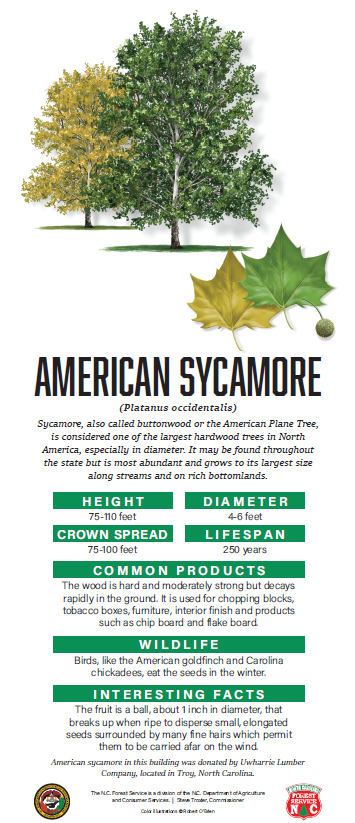 Sycamore, also called buttonwood or the American Plane Tree, is considered one of the largest hardwood trees in North America, especially in diameter. It may be found throughout the state but is most abundant and grows to its largest size along streams and on rich bottomlands.
Sycamore, also called buttonwood or the American Plane Tree, is considered one of the largest hardwood trees in North America, especially in diameter. It may be found throughout the state but is most abundant and grows to its largest size along streams and on rich bottomlands.
| Height: 75-110 feet | Diameter: 4-6 feet | |
| Crown Spread: 75-100 feet | Lifespan: 250 years |
Wildlife: Birds like the American goldfinch and Carolina chickadees eat the seeds in the winter.
Interesting Facts: The fruit is a ball, about 1 inch in diameter, that breaks up when ripe to disperse small, elongated seeds surrounded by many fine hairs which permit them to be carried afar on the wind.
American sycamore in this building was donated by Uwharrie Lumber Company, located in Troy, North Carolina.
Atlantic White Cedar (Chamaecyparis thyoides)
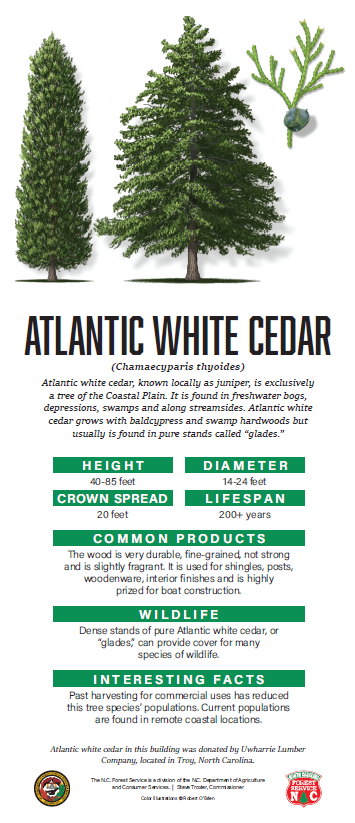 Atlantic white cedar, known locally as juniper, is exclusively a tree of the Coastal Plain. It is found in freshwater bogs, depressions, swamps and along streamsides. Atlantic white cedar grows with baldcypress and swamp hardwoods but usually is found in pure stands called “glades.”
Atlantic white cedar, known locally as juniper, is exclusively a tree of the Coastal Plain. It is found in freshwater bogs, depressions, swamps and along streamsides. Atlantic white cedar grows with baldcypress and swamp hardwoods but usually is found in pure stands called “glades.”
| Height: 40-85 feet | Diameter: 14-24 feet | |
| Crown Spread: 20 feet | Lifespan: 200+ years |
Wildlife: Dense stands of Atlantic white cedar can provide cover for many species of wildlife
Interesting Facts: Past harvesting for commercial uses has reduced this tree species’ populations. Current populations are found in remote coastal locations.
Atlantic white cedar in this building was donated by Uwharrie Lumber Company, located in Troy, North Carolina.
Baldcypress (Taxodium distichum)
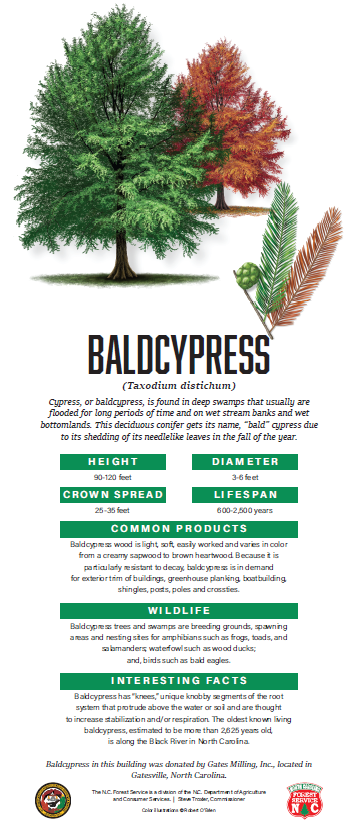 Cypress, or baldcypress, is found in deep swamps that usually are flooded for long periods of time and on wet stream banks and wet bottomlands. This deciduous conifer gets its name, “bald” cypress due
to its shedding of its needlelike leaves in the fall of the year.
Cypress, or baldcypress, is found in deep swamps that usually are flooded for long periods of time and on wet stream banks and wet bottomlands. This deciduous conifer gets its name, “bald” cypress due
to its shedding of its needlelike leaves in the fall of the year.
| Height: 90-120 feet | Diameter: 3-6 feet | |
| Crown Spread: 25-35 feet | Lifespan: 600-2,500 years |
Wildlife: Provides breeding grounds, spawning areas, and nesting sites for frogs, toads, salamanders, wood ducks, bald eagles and more.
Interesting Facts: Baldcypress has “knees,” unique knobby segments of the root system that protrude above the water or soil and are thought to increase stabilization and/or respiration. The oldest known living baldcypress, estimated to be more than 2,625 years old, is along the Black River in North Carolina.
Baldcypress in this building was donated by Gates Milling, Inc., located in Gatesville, North Carolina.
Black Cherry (Prunus serotina)
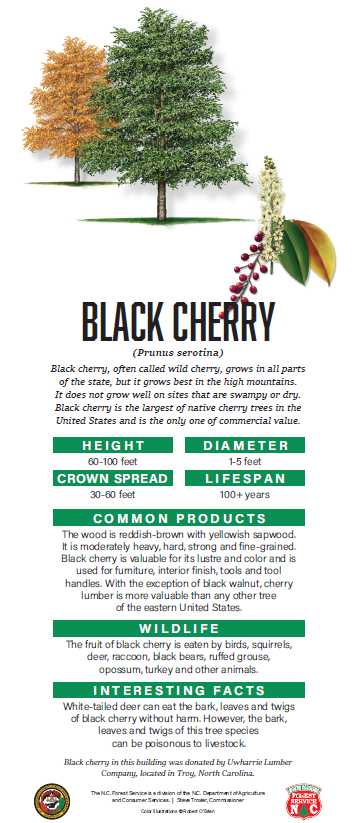 Black cherry, often called wild cherry, grows in all parts of the state, but it grows best in the high mountains. It does not grow well on sites that are swampy or dry. Black cherry is the largest of native cherry trees in the United States and is the only one of commercial value.
Black cherry, often called wild cherry, grows in all parts of the state, but it grows best in the high mountains. It does not grow well on sites that are swampy or dry. Black cherry is the largest of native cherry trees in the United States and is the only one of commercial value.
| Height: 60-100 feet | Diameter: 1-5 feet | |
| Crown Spread: 30-60 feet | Lifespan: 100+ years |
Wildlife: The fruit of black cherry is eaten by birds, squirrels, deer, raccoon, black bears, opossum, turkey and other animals.
Interesting Facts: White-tailed deer can eat the bark, leaves and twigs of black cherry without harm. However, the bark, leaves and twigs of this tree species can be poisonous to livestock.
Black cherry in this building was donated by Uwharrie Lumber Company, located in Troy, North Carolina.
Black Locust (Robinia pseudoacacia)
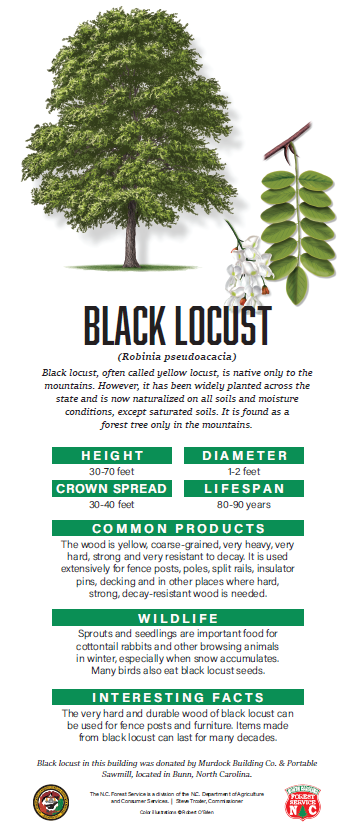 Black locust, often called yellow locust, is native only to the mountains. However, it has been widely planted across the state and is now naturalized on all soils and moisture conditions, except saturated soils. It is found as a forest tree only in the mountains.
Black locust, often called yellow locust, is native only to the mountains. However, it has been widely planted across the state and is now naturalized on all soils and moisture conditions, except saturated soils. It is found as a forest tree only in the mountains.
| Height: 30-70 feet | Diameter: 1-2 feet | |
| Crown Spread: 30-40 feet | Lifespan: 80-90 years |
Wildlife: Sprouts and seedlings are important food for cottontail rabbits and other animals in the winter. Many birds also eat Black locust seeds.
Interesting Facts: The very hard and durable wood of black locust can be used for fence posts and furniture. Items made from black locust can last for many decades.
Black locust in this building was donated by Murdock Building Co. & Portable Sawmill, located in Bunn, North Carolina.
Black Walnut (Juglans nigra)
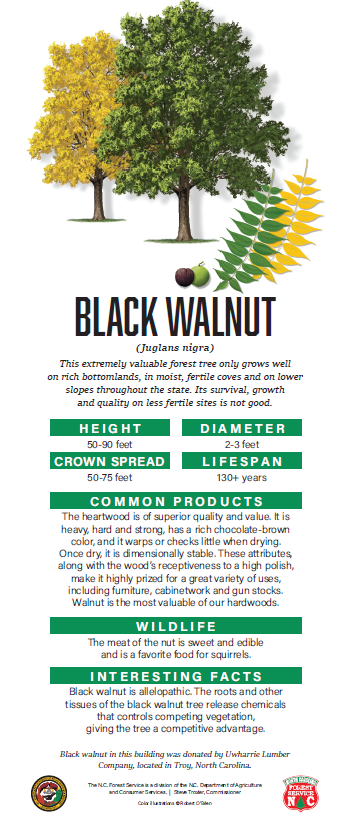 This extremely valuable forest tree only grows well on rich bottomlands, in moist, fertile coves and on lower slopes throughout the state. Its survival, growth
and quality on less fertile sites is not good.
This extremely valuable forest tree only grows well on rich bottomlands, in moist, fertile coves and on lower slopes throughout the state. Its survival, growth
and quality on less fertile sites is not good.
| Height: 50-90 feet | Diameter: 2-3 feet | |
| Crown Spread: 50-70 feet | Lifespan: 130+ years |
Wildlife: The meat of the nut is sweet and edible and is a favorite food for squirrels.
Interesting Facts: Black walnut is allelopathic. The roots and other tissues of the black walnut tree release chemicals that controls competing vegetation, giving the tree a competitive advantage.
Black walnut in this building was donated by Uwharrie Lumber Company, located in Troy, North Carolina.
Blackgum (Nyssa sylvatica)
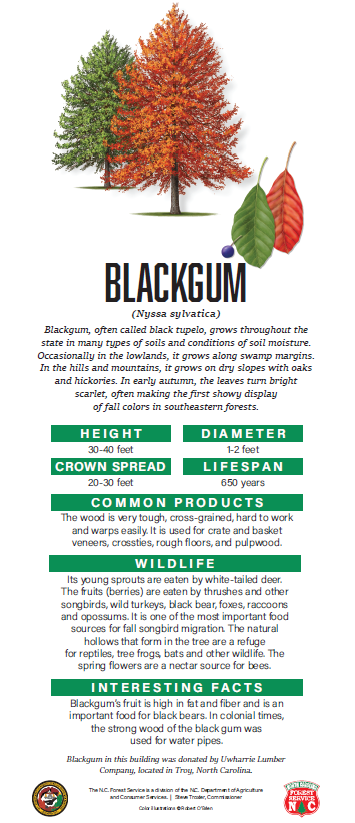 Blackgum, often called black tupelo, grows throughout the state in many types of soils and conditions of soil moisture. Occasionally in the lowlands, it grows along swamp margins. In the hills and mountains, it grows on dry slopes with oaks and hickories. In early autumn, the leaves turn bright scarlet, often making the first showy display of fall colors in southeastern forests.
Blackgum, often called black tupelo, grows throughout the state in many types of soils and conditions of soil moisture. Occasionally in the lowlands, it grows along swamp margins. In the hills and mountains, it grows on dry slopes with oaks and hickories. In early autumn, the leaves turn bright scarlet, often making the first showy display of fall colors in southeastern forests.
| Height: 30-40 feet | Diameter: 1-2 feet | |
| Crown Spread: 20-30 feet | Lifespan: 650 years |
Wildlife: Its young sprouts are eaten by white-tailed deer. The fruits are eaten by songbirds, wild turkeys, black bears, foxes and more. It is one of the most important food sources for fall songbird migration. The spring flowers are a nectar source for bees.
Interesting Facts: Blackgum’s fruit is high in fat and fiber and is an important food for black bears. In colonial times, the strong wood of the black gum was used for water pipes.
Blackgum in this building was donated by Uwharrie Lumber Company, located in Troy, North Carolina.
Box Elder (Acer negundo)
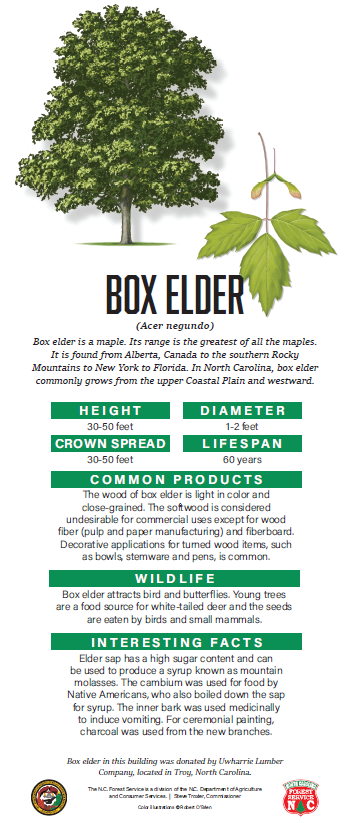 Box elder is a maple. Its range is the greatest of all the maples. It is found from Alberta, Canada to the southern Rocky Mountains to New York to Florida. In North Carolina, box elder commonly grows from the upper Coastal Plain and westward.
Box elder is a maple. Its range is the greatest of all the maples. It is found from Alberta, Canada to the southern Rocky Mountains to New York to Florida. In North Carolina, box elder commonly grows from the upper Coastal Plain and westward.
| Height: 30-50 feet | Diameter: 1-2 feet | |
| Crown Spread: 30-50 feet | Lifespan: 60 years |
Wildlife: Box elder attracts bird and butterflies. Young trees are a food source for white-tailed deer and the seeds are eaten by birds and small mammals.
Interesting Facts: Elder sap has a high sugar content and can be used to produce a syrup known as mountain molasses. The cambium was used for food by Native Americans, who also boiled down the sap for syrup. The inner bark was used medicinally to induce vomiting. For ceremonial painting, charcoal was used from the new branches.
Box elder in this building was donated by Uwharrie Lumber Company, located in Troy, North Carolina.
Common Persimmon (Diospyros virginiana)
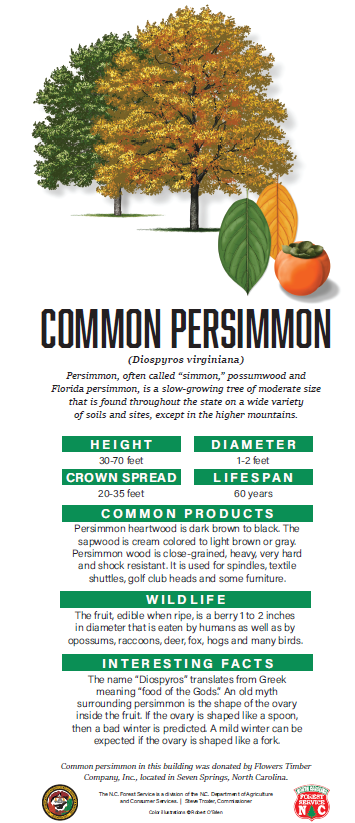 Persimmon, often called “simmon,” possumwood and Florida persimmon, is a slow-growing tree of moderate size that is found throughout the state on a wide variety of soils and sites, except in the higher mountains.
Persimmon, often called “simmon,” possumwood and Florida persimmon, is a slow-growing tree of moderate size that is found throughout the state on a wide variety of soils and sites, except in the higher mountains.
| Height: 30-70 feet | Diameter: 1-2 feet | |
| Crown Spread: 20-35 feet | Lifespan: 60 years |
Wildlife: The fruit, edible when ripe, is a berry 1 to 2 inches in diameter that is eaten by humans as well as by opossums, raccoons, deer, fox, hogs and many birds.
Interesting Facts: The name “Diospyros” translates from Greek meaning “food of the Gods.” An old myth surrounding persimmon is the shape of the ovary inside the fruit. If the ovary is shaped like a spoon, then a bad winter is predicted. A mild winter can be expected if the ovary is shaped like a fork.
Common persimmon in this building was donated by Flowers Timber Company, Inc., located in Seven Springs, North Carolina.
Eastern Cottonwood (Populus deltoides)
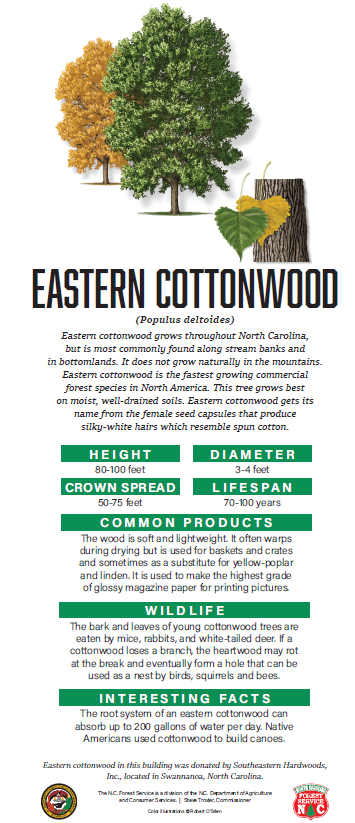 Eastern cottonwood grows throughout North Carolina, but is most commonly found along stream banks and in bottomlands. It does not grow naturally in the mountains. Eastern cottonwood is the fastest growing commercial forest species in North America. This tree grows best on moist, well-drained soils. Eastern cottonwood gets its name from the female seed capsules that produce silky-white hairs which resemble spun cotton.
Eastern cottonwood grows throughout North Carolina, but is most commonly found along stream banks and in bottomlands. It does not grow naturally in the mountains. Eastern cottonwood is the fastest growing commercial forest species in North America. This tree grows best on moist, well-drained soils. Eastern cottonwood gets its name from the female seed capsules that produce silky-white hairs which resemble spun cotton.
| Height: 80-100 feet | Diameter: 3-4 feet | |
| Crown Spread: 50-75 feet | Lifespan: 70-100 years |
Wildlife: The bark and leaves of young cottonwood trees are eaten by mice, rabbits, and white-tailed deer.
Interesting Facts: The root system of an eastern cottonwood can absorb up to 200 gallons of water per day. Native Americans used cottonwood to build canoes.
Eastern cottonwood in this building was donated by Southeastern Hardwoods, Inc., located in Swannanoa, North Carolina.
Eastern Hemlock (Tsuga canadensis (L.) Carr.)
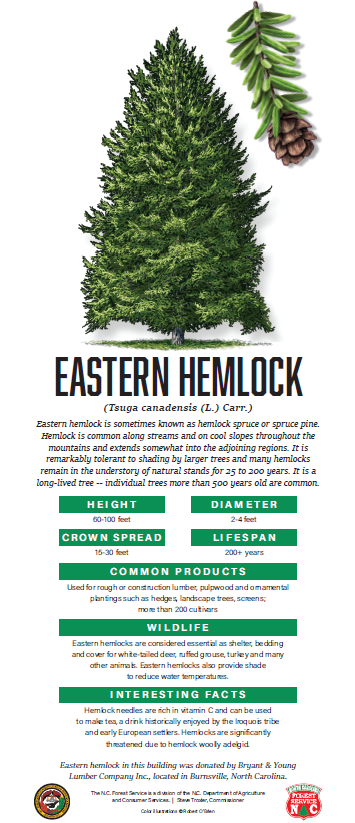 Eastern hemlock is sometimes known as hemlock spruce or spruce pine. Hemlock is common along streams and on cool slopes throughout the mountains and extends somewhat into the adjoining regions. It is remarkably tolerant to shading by larger trees and many hemlocks remain in the understory of natural stands for 25 to 200 years. It is a long-lived tree -- individual trees more than 500 years old are common.
Eastern hemlock is sometimes known as hemlock spruce or spruce pine. Hemlock is common along streams and on cool slopes throughout the mountains and extends somewhat into the adjoining regions. It is remarkably tolerant to shading by larger trees and many hemlocks remain in the understory of natural stands for 25 to 200 years. It is a long-lived tree -- individual trees more than 500 years old are common.
| Height: 60-100 feet | Diameter: 2-4 feet | |
| Crown Spread: 15-30 feet | Lifespan: 200+ years |
Wildlife: This tree is considered essential as shelter, bedding and cover for white-tailed deer, ruffed grouse, turkey and many other animals.
Interesting Facts: Hemlock needles are rich in vitamin C and can be used to make tea, a drink historically enjoyed by the Iroquois tribe and early European settlers. Hemlocks are significantly threatened due to hemlock woolly adelgid.
Eastern hemlock in this building was donated by Bryant & Young Lumber Company Inc., located in Burnsville, North Carolina.
Eastern Red Cedar (Juniperus virginiana)
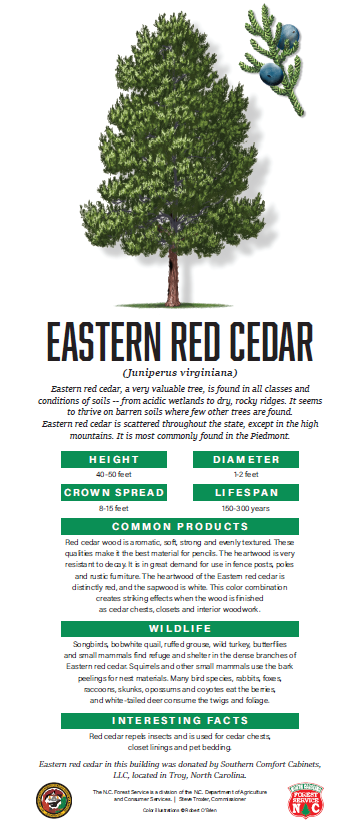 Eastern red cedar, a very valuable tree, is found in all classes and conditions of soils -- from acidic wetlands to dry, rocky ridges. It seems to thrive on barren soils where few other trees are found. Eastern red cedar is scattered throughout the state, except in the high mountains. It is most commonly found in the Piedmont.
Eastern red cedar, a very valuable tree, is found in all classes and conditions of soils -- from acidic wetlands to dry, rocky ridges. It seems to thrive on barren soils where few other trees are found. Eastern red cedar is scattered throughout the state, except in the high mountains. It is most commonly found in the Piedmont.
| Height: 40-50 feet | Diameter: 1-2 feet | |
| Crown Spread: 8-15 feet | Lifespan: 150-300 years |
Wildlife: A sheltering tree for butterflies, mammals, and birds. Squirrels and other mammals use the bark for nest materials. Many species eat the berries.
Interesting Facts: Red cedar repels insects and is used for cedar chests, closet linings and pet bedding.
Eastern red cedar in this building was donated by Southern Comfort Cabinets, LLC, located in Troy, North Carolina.
Eastern White Pine (Pinus strobus)
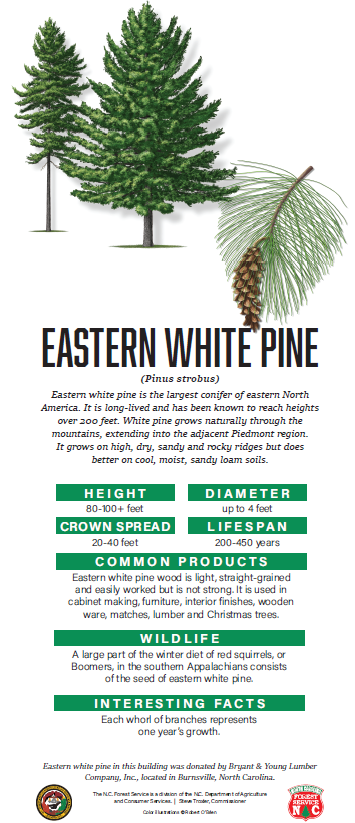 Eastern white pine is the largest conifer of eastern North America. It is long-lived and has been known to reach heights over 200 feet. White pine grows naturally through the mountains, extending into the adjacent Piedmont region. It grows on high, dry, sandy and rocky ridges but does better on cool, moist, sandy loam soils.
Eastern white pine is the largest conifer of eastern North America. It is long-lived and has been known to reach heights over 200 feet. White pine grows naturally through the mountains, extending into the adjacent Piedmont region. It grows on high, dry, sandy and rocky ridges but does better on cool, moist, sandy loam soils.
| Height: 80-100+ feet | Diameter: Up to 4 feet | |
| Crown Spread: 20-40 feet | Lifespan: 200-450 years |
Wildlife: The seeds are a large part of the winter diet for red squirrels.
Interesting Facts: Each whorl of branches represents one year’s growth.
Eastern white pine in this building was donated by Bryant & Young Lumber Company, Inc., located in Burnsville, North Carolina.
Green Ash (Fraxinus pennsylvanica)
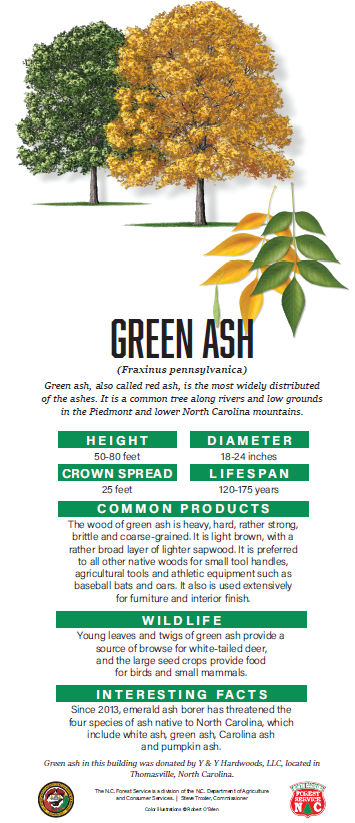 Green ash, also called red ash, is the most widely distributed of the ashes. It is a common tree along rivers and low grounds in the Piedmont and lower North Carolina mountains.
Green ash, also called red ash, is the most widely distributed of the ashes. It is a common tree along rivers and low grounds in the Piedmont and lower North Carolina mountains.
| Height: 50-80 feet | Diameter: 18-24 inches | |
| Crown Spread: 25 feet | Lifespan: 120-175 years |
Wildlife: Large seed crops provide food for birds and small mammals. Young leaves and twigs provide a source of browse for white-tailed deer.
Interesting Facts: Since 2013, emerald ash borer has threatened the four species of ash native to North Carolina, which include white ash, green ash, Carolina ash and pumpkin ash.
Green ash in this building was donated by Y & Y Hardwoods, LLC, located in Thomasville, North Carolina.
Loblolly Pine (Pinus taeda)
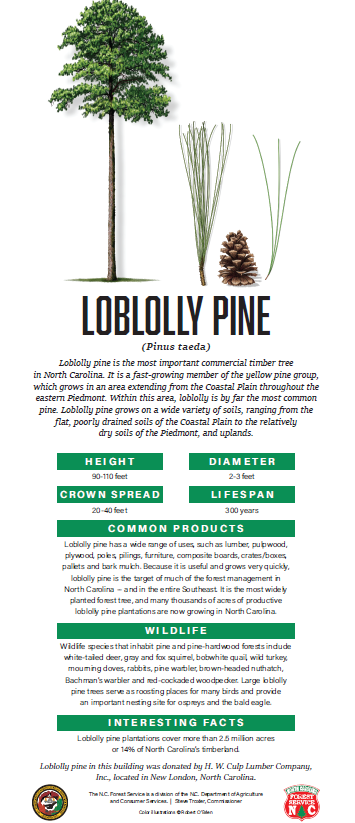 Loblolly pine is the most important commercial timber tree in North Carolina. It is a fast-growing member of the yellow pine group, which grows in an area extending from the Coastal Plain throughout the eastern Piedmont. Within this area, loblolly is by far the most common pine. Loblolly pine grows on a wide variety of soils, ranging from the flat, poorly drained soils of the Coastal Plain to the relatively dry soils of the Piedmont, and uplands.
Loblolly pine is the most important commercial timber tree in North Carolina. It is a fast-growing member of the yellow pine group, which grows in an area extending from the Coastal Plain throughout the eastern Piedmont. Within this area, loblolly is by far the most common pine. Loblolly pine grows on a wide variety of soils, ranging from the flat, poorly drained soils of the Coastal Plain to the relatively dry soils of the Piedmont, and uplands.
| Height: 90-100 feet | Diameter: 2-3 feet | |
| Crown Spread: 20-40 feet | Lifespan: 300 years |
Wildlife: Large loblolly pine trees serve as roosting places for many birds and provide an important nesting site for ospreys and bald eagles.
Interesting Facts: Loblolly pine plantations cover more than 2.5 million acres or 14% of North Carolina’s timberland.
Loblolly pine in this building was donated by H. W. Culp Lumber Company, Inc., located in New London, North Carolina.
Longleaf Pine (Pinus palustris)
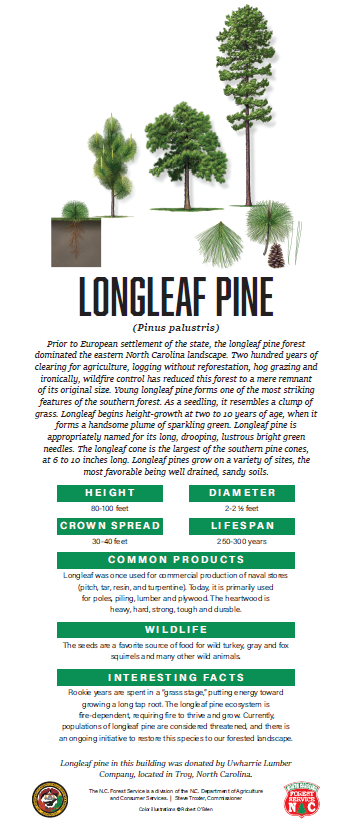 Prior to European settlement of the state, the longleaf pine forest dominated the eastern North Carolina landscape. Two hundred years of clearing for agriculture, logging without reforestation, hog grazing and ironically, wildfire control has reduced this forest to a mere remnant of its original size. Longleaf pine is
appropriately named for its long, drooping, lustrous bright green needles. The longleaf cone is the largest of the southern pine cones, at 6 to 10 inches long.
Prior to European settlement of the state, the longleaf pine forest dominated the eastern North Carolina landscape. Two hundred years of clearing for agriculture, logging without reforestation, hog grazing and ironically, wildfire control has reduced this forest to a mere remnant of its original size. Longleaf pine is
appropriately named for its long, drooping, lustrous bright green needles. The longleaf cone is the largest of the southern pine cones, at 6 to 10 inches long.
| Height: 80-100 feet | Diameter: 2-2.5 feet | |
| Crown Spread: 30-40 feet | Lifespan: 250-300 years |
Wildlife: The seeds are a favorite source of food for wild turkey, gray and fox squirrels and many other wild animals.
Interesting Facts: Rookie years are spent in a “grass stage,” putting energy toward growing a long tap root. The longleaf pine ecosystem is fire-dependent, requiring fire to thrive and grow. Currently, populations of longleaf pine are considered threatened, and there is an ongoing initiative to restore this species to our forested landscape.
Longleaf pine in this building was donated by Uwharrie Lumber Company, located in Troy, North Carolina.
Red Maple (Acer rubrum)
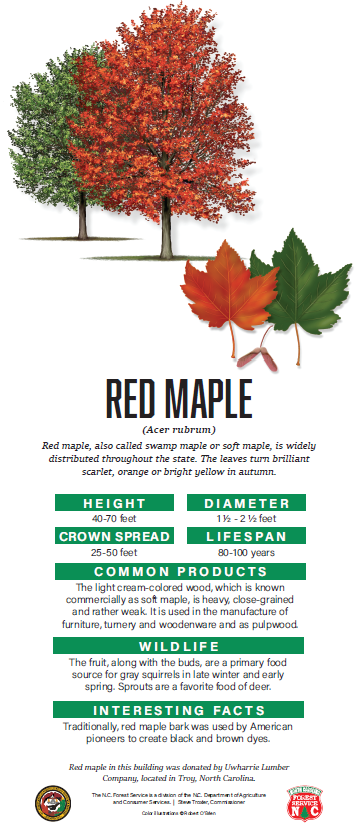 Red maple, also called swamp maple or soft maple, is widely distributed throughout the state. The leaves turn brilliant scarlet, orange or bright yellow in autumn.
Red maple, also called swamp maple or soft maple, is widely distributed throughout the state. The leaves turn brilliant scarlet, orange or bright yellow in autumn.
| Height: 40-70 feet | Diameter: 1.5-2.5 feet | |
| Crown Spread: 25-50 feet | Lifespan: 80-100 years |
Wildlife: The fruit, along with the buds, are a primary food source for gray squirrels in late winter and early spring. Sprouts are a favorite food of deer.
Interesting Facts: Traditionally, red maple bark was used by American pioneers to create black and brown dyes.
Red maple in this building was donated by Uwharrie Lumber Company, located in Troy, North Carolina.
Sassafras (Sassafras albidium)
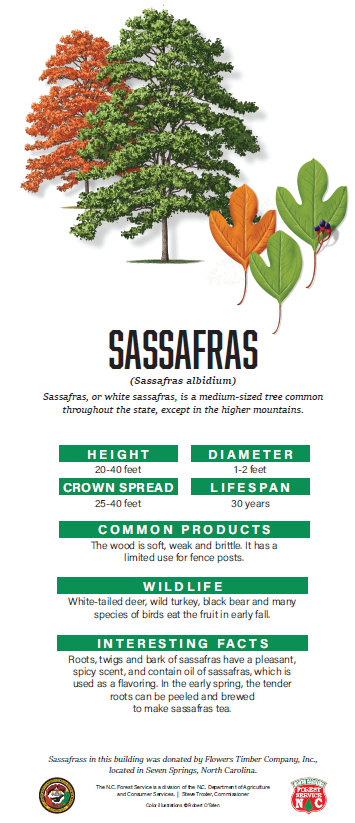 Sassafras, or white sassafras, is a medium-sized tree common throughout the state, except in the higher mountains.
Sassafras, or white sassafras, is a medium-sized tree common throughout the state, except in the higher mountains.
| Height: 20-40 feet | Diameter: 1-2 feet | |
| Crown Spread: 25-40 feet | Lifespan: 30 years |
Wildlife: White-tailed deer, wild turkey, black bear and many species of birds eat the fruit in early fall.
Interesting Facts: Roots, twigs and bark of sassafras have a pleasant, spicy scent, and contain oil of sassafras, which is used as a flavoring. In the early spring, the tender roots can be peeled and brewed to make sassafras tea
Sassafrass in this building was donated by Flowers Timber Company, Inc., located in Seven Springs, North Carolina.
Shagbark Hickory (Carya Ovata)
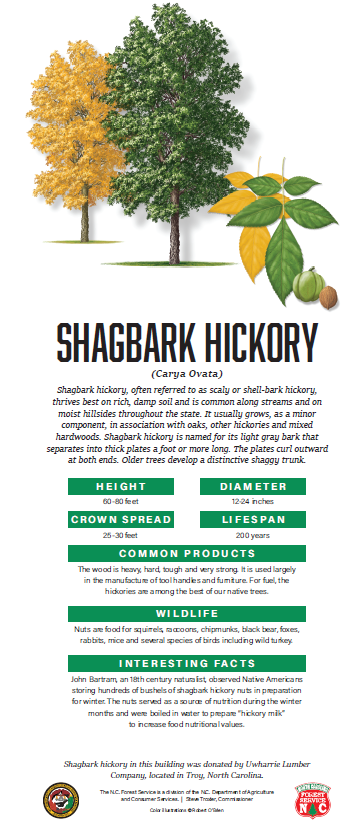 Shagbark hickory, often referred to as scaly or shell-bark hickory, thrives best on rich, damp soil and is common along streams and on moist hillsides throughout the state. It usually grows, as a minor component, in association with oaks, other hickories and mixed hardwoods. Shagbark hickory is named for its light gray bark that separates into thick plates a foot or more long. The plates curl outward at both ends. Older trees develop a distinctive shaggy trunk.
Shagbark hickory, often referred to as scaly or shell-bark hickory, thrives best on rich, damp soil and is common along streams and on moist hillsides throughout the state. It usually grows, as a minor component, in association with oaks, other hickories and mixed hardwoods. Shagbark hickory is named for its light gray bark that separates into thick plates a foot or more long. The plates curl outward at both ends. Older trees develop a distinctive shaggy trunk.
| Height: 60-80 feet | Diameter: 12-24 inches | |
| Crown Spread: 25-30 feet | Lifespan: 200 years |
Wildlife: Nuts are food for squirrels, raccoons, chipmunks, black bear, foxes, rabbits, mice and several species of birds including wild turkey.
Interesting Facts: John Bartram, an 18th century naturalist, observed Native Americans storing hundreds of bushels of shagbark hickory nuts in preparation for winter. The nuts served as a source of nutrition during the winter months and were boiled in water to prepare “hickory milk” to increase food nutritional values.
Shagbark hickory in this building was donated by Uwharrie Lumber Company, located in Troy, North Carolina.
Shortleaf Pine (Ulmus rubra)
 Shortleaf pine, also known as rosemary pine, yellow pine, and old-field pine, is widely distributed throughout the South. This tree species can be found in pure or mixed stands from the Coastal Plain to the uplands and lower mountain slopes. In the lower mountains, it grows with hardwoods and four other species of pine: white; pitch; Virginia; and, Table Mountain.
Shortleaf pine, also known as rosemary pine, yellow pine, and old-field pine, is widely distributed throughout the South. This tree species can be found in pure or mixed stands from the Coastal Plain to the uplands and lower mountain slopes. In the lower mountains, it grows with hardwoods and four other species of pine: white; pitch; Virginia; and, Table Mountain.
| Height: 80-100 feet | Diameter: 2-3 feet | |
| Crown Spread: 20-40 feet | Lifespan: 170-200 years |
Wildlife: Seeds are eaten by rodents, wild turkey, squirrels and some songbirds.
Interesting Facts: Shortleaf pine is unique from other pines because the seedlings can sprout back quickly after being killed by fire. Shortleaf pine’s scientific name is Latin for hedgehog (echinus). The prickles on the cone give it a spiny “hedgehog-like” appearance.
Shortleaf pine in this building was donated by American Woodyards, LLC, located in Raleigh, North Carolina.
Slippery Elm (Ulmus rubra)
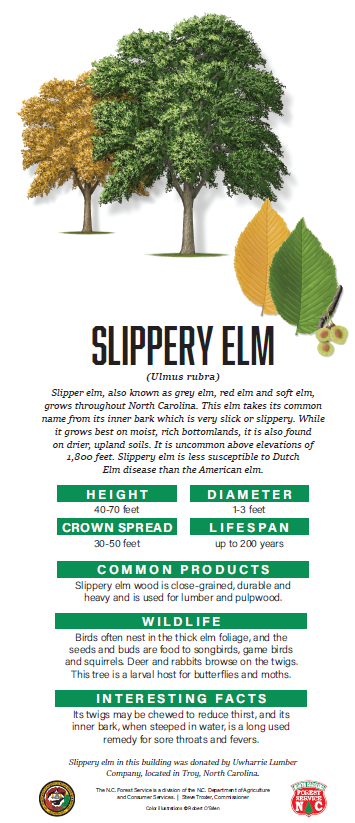 Slipper elm, also known as grey elm, red elm and soft elm, grows throughout North Carolina. This elm takes its common name from its inner bark which is very slick or slippery. While it grows best on moist, rich bottomlands, it is also found on drier, upland soils. It is uncommon above elevations of 1,800 feet. Slippery elm is less susceptible to Dutch Elm disease than the American elm.
Slipper elm, also known as grey elm, red elm and soft elm, grows throughout North Carolina. This elm takes its common name from its inner bark which is very slick or slippery. While it grows best on moist, rich bottomlands, it is also found on drier, upland soils. It is uncommon above elevations of 1,800 feet. Slippery elm is less susceptible to Dutch Elm disease than the American elm.
| Height: 40-70 feet | Diameter: 1-3 feet | |
| Crown Spread: 30-50 feet | Lifespan: up to 200 years |
Wildlife: Birds often nest in the thick elm foliage, and the seeds and buds are food to songbirds, game birds and squirrels. Deer and rabbits browse on the twigs. This tree is a larval host for butterflies and moths.
Interesting Facts: Its twigs may be chewed to reduce thirst, and its inner bark, when steeped in water, is a long used remedy for sore throats and fevers.
Slippery elm in this building was donated by Uwharrie Lumber Company, located in Troy, North Carolina.
Southern Red Oak (Quercus falcata)
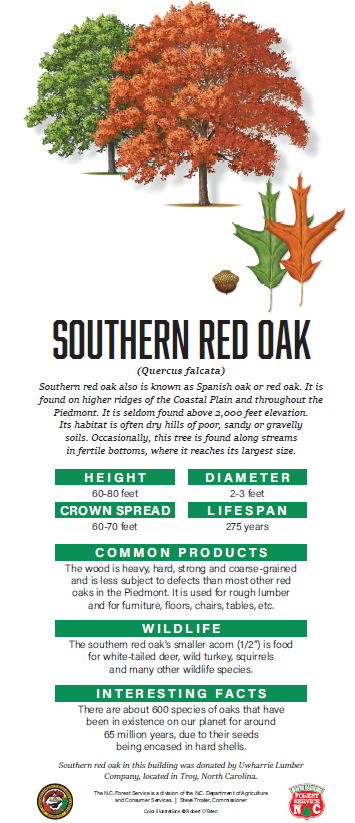 Southern red oak also is known as Spanish oak or red oak. It is found on higher ridges of the Coastal Plain and throughout the Piedmont. It is seldom found above 2,000 feet elevation. Its habitat is often dry hills of poor, sandy or gravelly soils. Occasionally, this tree is found along streams in fertile bottoms, where it reaches its largest size.
Southern red oak also is known as Spanish oak or red oak. It is found on higher ridges of the Coastal Plain and throughout the Piedmont. It is seldom found above 2,000 feet elevation. Its habitat is often dry hills of poor, sandy or gravelly soils. Occasionally, this tree is found along streams in fertile bottoms, where it reaches its largest size.
| Height: 60-80 feet | Diameter: 2-3 feet | |
| Crown Spread: 60-70 feet | Lifespan: 275 years |
Wildlife: The southern red oak’s smaller acorn is food for white-tailed deer, wild turkey, squirrels and many other wildlife species.
Interesting Facts: There are about 600 species of oaks that have been in existence on our planet for around 65 million years, due to their seeds being encased in hard shells.
Southern red oak in this building was donated by Uwharrie Lumber Company, located in Troy, North Carolina.
Sugar Maple (Acer saccharum)
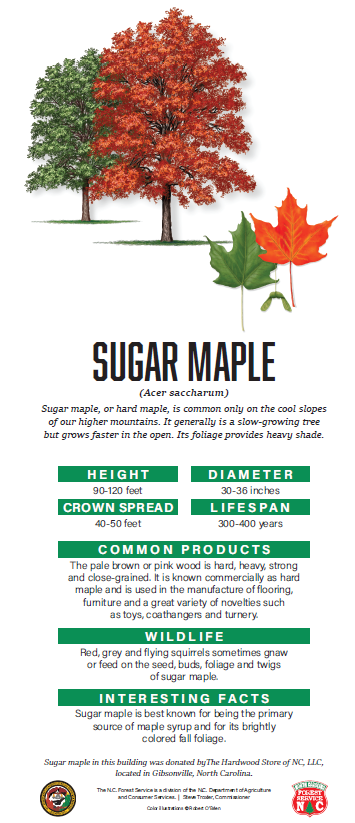 Sugar maple, or hard maple, is common only on the cool slopes of our higher mountains. It generally is a slow-growing tree but grows faster in the open. Its foliage provides heavy shade.
Sugar maple, or hard maple, is common only on the cool slopes of our higher mountains. It generally is a slow-growing tree but grows faster in the open. Its foliage provides heavy shade.
| Height: 90-120 feet | Diameter: 30-36 inches | |
| Crown Spread: 40-60 feet | Lifespan: 300-400 years |
Wildlife: Red, grey and flying squirrels sometimes gnaw or feed on the seed, buds, foliage and twigs of sugar maple.
Interesting Facts: Sugar maple is best known for being the primary source of maple syrup and for its brightly colored fall foliage.
Sugar maple in this building was donated by The Hardwood Store of NC, LLC, located in Gibsonville, North Carolina.
Sweetgum (Liquidambar styraciflua)
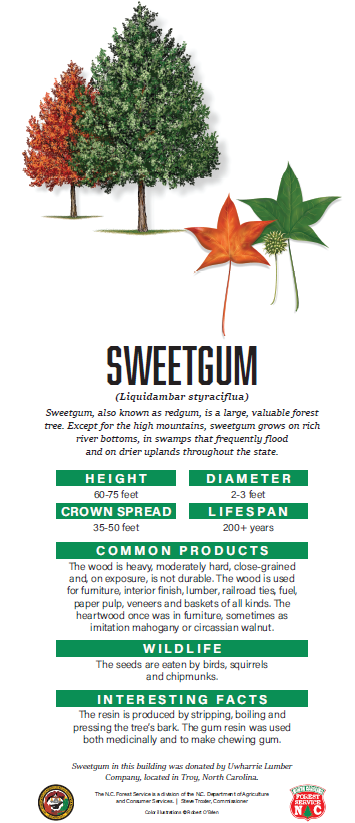 Sweetgum, also known as redgum, is a large, valuable forest tree. Except for the high mountains, sweetgum grows on rich river bottoms, in swamps that frequently flood and on drier uplands throughout the state.
Sweetgum, also known as redgum, is a large, valuable forest tree. Except for the high mountains, sweetgum grows on rich river bottoms, in swamps that frequently flood and on drier uplands throughout the state.
| Height: 60-75 feet | Diameter: 2-3 feet | |
| Crown Spread: 35-50 feet | Lifespan: 200+ years |
Wildlife: The seeds are eaten by birds, squirrels and chipmunks.
Interesting Facts: The resin is produced by stripping, boiling and pressing the tree’s bark. The gum resin was used both medicinally and to make chewing gum.
Sweetgum in this building was donated by Uwharrie Lumber Company, located in Troy, North Carolina.
White Oak (Quercus alba)
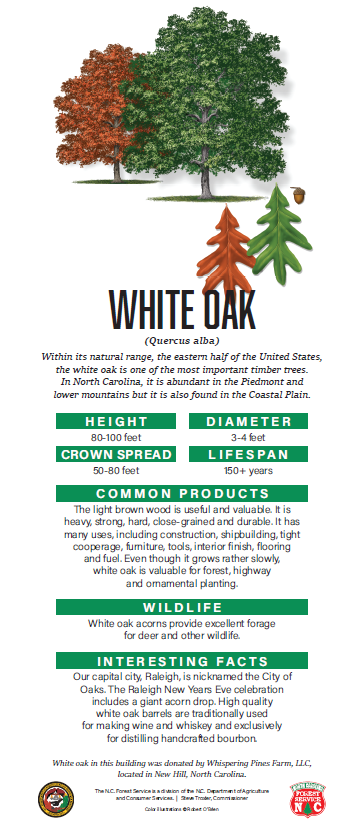 Within its natural range, the eastern half of the United States, the white oak is one of the most important timber trees. In North Carolina, it is abundant in the Piedmont and lower mountains but it is also found in the Coastal Plain.
Within its natural range, the eastern half of the United States, the white oak is one of the most important timber trees. In North Carolina, it is abundant in the Piedmont and lower mountains but it is also found in the Coastal Plain.
| Height: 80-100 feet | Diameter: 3-4 feet | |
| Crown Spread: 50-80 feet | Lifespan: 150+ years |
Wildlife: White oak acorns provide excellent forage for deer and other wildlife.
Interesting Facts: Our capital city, Raleigh, is nicknamed the City of Oaks. The Raleigh New Years Eve celebration includes a giant acorn drop. High quality white oak barrels are traditionally used for making wine and whiskey and exclusively for distilling handcrafted bourbon.
White oak in this building was donated by Whispering Pines Farm, LLC, located in New Hill, North Carolina.
Yellow Birch (Betula alleghaniensis)
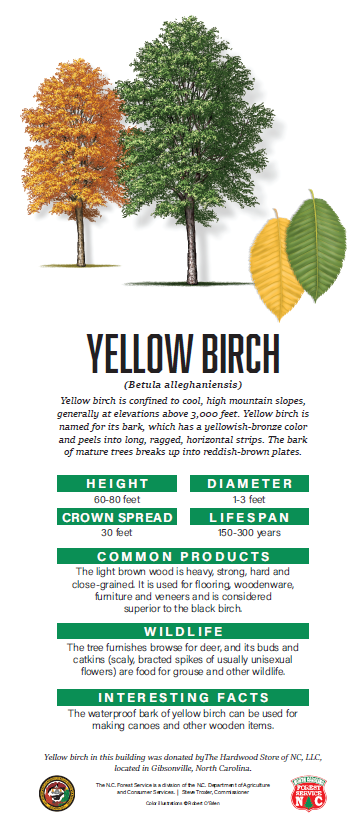 Yellow birch is confined to cool, high mountain slopes, generally at elevations above 3,000 feet. Yellow birch is named for its bark, which has a yellowish-bronze color and peels into long, ragged, horizontal strips. The bark of mature trees breaks up into reddish-brown plates.
Yellow birch is confined to cool, high mountain slopes, generally at elevations above 3,000 feet. Yellow birch is named for its bark, which has a yellowish-bronze color and peels into long, ragged, horizontal strips. The bark of mature trees breaks up into reddish-brown plates.
| Height: 60-80 feet | Diameter: 1-3 feet | |
| Crown Spread: 30 feet | Lifespan: 150-300 years |
Wildlife: The tree furnishes browse for deer, and its buds and catkins (scaly, bracted spikes of usually unisexual flowers) are food for grouse and other wildlife.
Interesting Facts: The waterproof bark of yellow birch can be used for making canoes and other wooden items.
Yellow birch in this building was donated byThe Hardwood Store of NC, LLC, located in Gibsonville, North Carolina.
Yellow-Poplar (Liriodendron tulipifera)
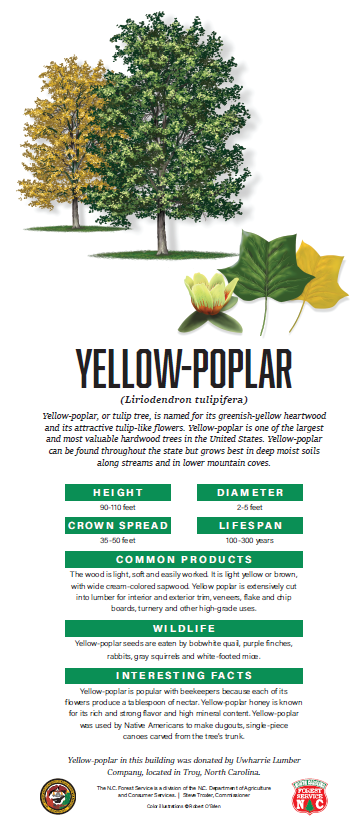 Yellow-poplar, or tulip tree, is named for its greenish-yellow heartwood and its attractive tulip-like flowers. Yellow-poplar is one of the largest and most valuable hardwood trees in the United States. Yellow-poplar can be found throughout the state but grows best in deep moist soils along streams and in lower mountain coves.
Yellow-poplar, or tulip tree, is named for its greenish-yellow heartwood and its attractive tulip-like flowers. Yellow-poplar is one of the largest and most valuable hardwood trees in the United States. Yellow-poplar can be found throughout the state but grows best in deep moist soils along streams and in lower mountain coves.
| Height: 90-110 feet | Diameter: 2-5 feet | |
| Crown Spread: 35-50 feet | Lifespan: 100-300 years |
Wildlife: Yellow-poplar seeds are eaten by bobwhite quail, purple finches, rabbits, gray squirrels and white-footed mice.
Interesting Facts: Yellow-poplar is popular with beekeepers because each of its flowers produce a tablespoon of nectar. Yellow-poplar honey is known for its rich and strong flavor and high mineral content. Yellow-poplar was used by Native Americans to make dugouts, single-piece canoes carved from the tree’s trunk.
Yellow-poplar in this building was donated by Uwharrie Lumber Company, located in Troy, North Carolina.
► Examples of North Carolina’s Minor Native Tree Species
American Elm (Ulmus americana)
This famous shade tree of New England, which is seriously threatened by the imported Dutch Elm disease, is found throughout North Carolina. It is most common on bottomlands and other fertile, moist soils. In dense forest stands, the tree will have a fairly narrow crown and a long, clear bole. Open-grown trees usually fork near the ground and develop arching crowns. The characteristic "urn" shape of the elms makes it easy to identify them even from a distance.
| Height: 70-100 feet | Diameter: 2-5 feet | |
| Crown Spread: 60-120 feet | Lifespan: 175-200 years |
Wildlife: The seeds are eaten by songbirds and small mammals.
Interesting Facts: Before the introduction of the Dutch elm disease, American Elm was used as a street tree. The Dutch elm disease is a fatal fungal disease that is spread by airborne bark beetles that attacks the water-conducting tissue of the tree, resulting in wilting, defoliation and death. There is no known cure.
American Elm donated by N.C. Forest Service Bladen Lakes State Forest - Elizabethtown, NC.
American Holly (Ilex opaca)
American holly, sometimes called Christmas holly, occurs sparingly throughout the state, from coastal floodplains to 4,500-foot elevations in the mountains. It grows best on a rich, moist soil but also is found in higher and drier conditions.
| Height: 15-40 feet | Diameter: 1-2 feet | |
| Crown Spread: 10-20 feet | Lifespan: up to 200 years |
Wildlife: The bitter-tasting berries are food for songbirds, bobwhite quail, white-tailed deer, squirrels, wild turkeys and a wide variety of other animals.
Interesting Facts: While many species of birds and mammals eat the American holly’s berries, the bitter fruit is poisonous to humans.
American Holly donated by N.C. Forest Service Bladen Lakes State Forest - Elizabethtown, NC
Chestnut Oak (Quercus prinus)
Chestnut oak acquired its name from its leaf, which resembles the chestnut leaf. Its ability to grow on rocky mountain ridges also has given it the name of rock oak or mountain oak. Although it is common on dry, rocky soils throughout the mountains it grows best in well-drained coves and bottomlands. Like most white oaks, chestnut oak grows slowly on almost all sites. Chestnut oak tends to form pure, open stands on the poorer sites of hillsides and mountain slopes but usually is mixed with other species such as hickories, other oaks and pitch pine, or shortleaf pine on better sites.
| Height: 50-70 feet | Diameter: 2-3 feet | |
| Crown Spread: 30-70 feet | Lifespan: 300-400 years |
Wildlife: Acorns are eaten by woodpeckers, blue jays, rough grouse, ducks, small mammals, wild turkeys, white-tailed deer, and black bears.
Interesting Facts: Before the 20th century, the bark of the chestnut oak was vital in the process of tanning leather because of its high volume of a compound called tannin.
Chestnut Oak donated by N.C. Forest Service District 2 - Lenoir, NC
Cucumber Tree (Magnolia acuminata)
Cucumber trees are found scattered among other hardwood trees throughout the richer, cooler slopes and coves of North Carolina's mountains. They also extend somewhat into nearby Piedmont areas.
| Height: 70-80 feet | Diameter: 2-4 feet | |
| Crown Spread: 35-60 feet | Lifespan: 80-120 years |
Wildlife: Twigs and buds are browsed by white-tailed deer. Seeds are eaten by birds and small mammals.
Interesting Facts: Early Americans once used immature cucumber tree fruit to flavor whiskey.
Cucumber Tree donated by N.C. Forest Service Jordan Lake Educational State Forest - Chapel Hill, NC.
Flowering Dogwood (Cornus florida)
Flowering dogwood is named and admired for the white drifts of flowers it adds to the woodlands in early spring. It grows throughout the state, usually under the larger forest trees. Since 1941, dogwood has the distinction of being the state flower.
| Height: 10-20 feet | Diameter: 4-6 inches | |
| Crown Spread: 15-30 feet | Lifespan: 80 years |
Wildlife: The fruits are food for more than 36 species of birds, including ruffed grouse, bobwhite quail and wild turkey. White-tailed deer, chipmunks, foxes, skunks, rabbits, beaver, black bears, squirrels and many other mammals eat the fruit, leaves and twigs.
Interesting Facts: Native Americans used the bark of flowering Dogwood roots to reduce fevers and aches.
Flowering Dogwood donated by N.C. Forest Service Jordan Lake Educational State Forest - Chapel Hill, NC.
Hackberry (Celtis occidentalis)
Hackberry can be sparsely found throughout the state, except in the high mountains. It is most abundant and reaches its greatest size in rich alluvial lands in the lower part of the state, but it can survive and grow on most types of soil, from the poorest to the richest.
| Height: 30-40 feet | Diameter: 1-2 feet | |
| Crown Spread: 40-60 feet | Lifespan: 150-200 years |
Wildlife: The fruit of the hackberry serves as a food source for many birds and small mammals. It also provides cover and nesting for birds. Cover is also provided for game birds, rabbits and deer.
Interesting Facts: Fleshy parts of the fruit are edible and somewhat sweet. The fruit can be eaten raw or used for making jellies and preserves.
Hackberry donated by N.C. Forest Service Clemmons Educational State Forest - Clayton, NC.
Post Oak (Quercus stellata)
Post oak can be found throughout the state. While it will grow in the mountains at elevations as high as 2,500 feet, it is most abundant on the poorer and drier soils of the Piedmont. The tree has alternate leaves with five lobes and a hairy, pale underside. The two middle lobes are distinctly square, resulting in an overall cruciform or “Maltese cross-like” appearance.
| Height: 40-50 feet | Diameter: 1-2 feet | |
| Crown Spread: 35-50 feet | Lifespan: 100-300 years |
Wildlife: The acorns are eaten by woodpeckers, blue jays, small mammals, wild turkeys, white-tailed deer, and black bear.
Interesting Facts: Post oak gets its name from the traditional use of the wood for fence posts.
Post Oak donated by N.C. Forest Service Jordan Lake Educational State Forest - Chapel Hill, NC.
Red Mulberry (Morus rubra)
Red mulberry grows throughout North Carolina. It grows best on the rich, red soils of the lower and middle sections of the state but is not abundant in any region. It is commonly called mulberry because there are no other native mulberry species within North Carolina. The fruit resembles that of blackberry. Fruits are red when immature, turning deep purple when ripe, usually during late June or July. Berries are 1 to 1 1/2 inches long, sweet, juicy and edible.
| Height: 20-30 feet | Diameter: up to 2 feet | |
| Crown Spread: 35-40 feet | Lifespan: 75 years |
Wildlife: The berry is a favorite food for gray squirrels, wild turkeys, foxes, opossums, raccoons, and many songbirds.
Interesting Facts: The unripen fruit and the milky white sap of the red mulberry is poisonous. Fruits that are eaten when ripe are harmless. Ripe fruits are sweet, juicy, and can be eaten raw or made into pies, jellies or jams. The ripe fruits are also used in breads, muffins, and cakes.
Red Mulberry donated by N.C. Forest Service Clemmons Educational State Forest - Clayton Hill, NC.
Sourwood (Oxydendrum arboreum)
Sourwood is found scattered throughout the state on both rich and poor soils but is least abundant in the low alluvial parts of the state. The tree has laurel-like alternate leaves that are finely toothed and sour to the taste (oxalic acid). Bees use the flower's nectar to make rich-colored honey which is widely enjoyed throughout the state.
| Height: 30-40 feet | Diameter: 8-12 inches | |
| Crown Spread: 10-15 feet | Lifespan: 80 years |
Wildlife: The flowers are attractive to butterflies and other insects. Natural hollows in these trees are refuge for climbing reptiles and amphibians, bats and other small wildlife. Flowers are quite attractive to bees and the honey is highly sought after
Interesting Facts: Bees produce a rich and popular honey from the nectar. A tea made from the leaves has been used in the treatment of asthma and indigestion.
Sourwood donated by N.C. Forest Service Clemmons Educational State Forest - Clayton Hill, NC.
Donors/Contributors
This building has been designed to showcase the diversity of North Carolina’s native tree species. The exterior is clad with yellow-poplar boards, and the interior wood panels represent nearly 30 tree species found throughout the Coastal Plain, Piedmont and Mountain regions of the “Old North State.” We greatly appreciate the members of North Carolina’s forestry community who donated and/or processed this wood for all to enjoy.
- American Woodyards, LLC located in Raleigh, North Carolina
- Beard Hardwoods, Inc. located in Greensboro, North Carolina
- Bryant & Young Lumber Co., Inc. located in Burnsville, North Carolina
- Flowers Timber Company, Inc. located in Seven Springs, North Carolina
- Gates Milling, Inc. located in Gatesville, North Carolina
- H.W. Culp Lumber Co., Inc. located in New London, North Carolina
- Kepley-Frank Hardwood Co., Inc. located in Lexington, North Carolina
- Murdock Building & Portable Sawmill located in Bunn, North Carolina
- Southeastern Hardwoods, Inc. located in Swannanoa, North Carolina
- Southern Comfort Cabinets located in Troy, North Carolina
- The Hardwood Store of NC, Inc. located in Gibsonville, North Carolina
- Uwharrie Lumber Co. located in Troy, North Carolina
- Whispering Pines Farms, LLC located in New Hill, North Carolina
- Y&Y Hardwoods, LLC located in Thomasville, North Carolina